Related Research Articles
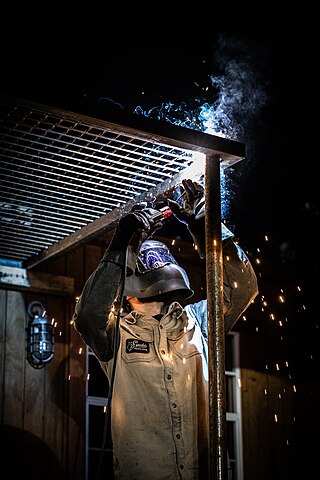
Welding is a fabrication process that joins materials, usually metals or thermoplastics, by using high heat to melt the parts together and allowing them to cool, causing fusion. Welding is distinct from lower temperature techniques such as brazing and soldering, which do not melt the base metal.

Spot welding is a type of electric resistance welding used to weld various sheet metal products, through a process in which contacting metal surface points are joined by the heat obtained from resistance to electric current.
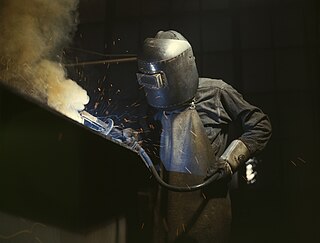
A welder is a person or equipment that fuses materials together. The term welder refers to the operator, the machine is referred to as the welding power supply. The materials to be joined can be metals or varieties of plastic or polymer. Welders typically have to have good dexterity and attention to detail, as well as technical knowledge about the materials being joined and best practices in the field.

Shielded metal arc welding (SMAW), also known as manual metal arc welding, flux shielded arc welding or informally as stick welding, is a manual arc welding process that uses a consumable electrode covered with a flux to lay the weld.
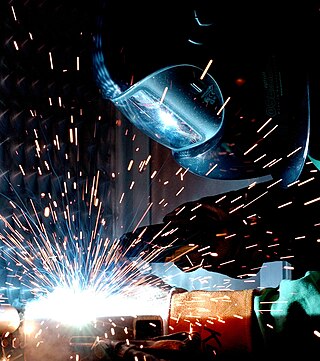
Arc welding is a welding process that is used to join metal to metal by using electricity to create enough heat to melt metal, and the melted metals, when cool, result in a binding of the metals. It is a type of welding that uses a welding power supply to create an electric arc between a metal stick ("electrode") and the base material to melt the metals at the point of contact. Arc welding power supplies can deliver either direct (DC) or alternating (AC) current to the work, while consumable or non-consumable electrodes are used.

Stud welding is a technique similar to flash welding where a fastener or specially formed nut is welded onto another metal part, typically a base metal or substrate. The fastener can take different forms, but typically fall under threaded, unthreaded, or tapped. The bolts may be automatically fed into the stud welder. Weld nuts generally have a flange with small nubs that melt to form the weld. Weld studs are used in stud welding systems. Manufacturers create weld studs for the two main forms of stud welding: capacitor discharge stud welding and drawn arc stud welding
Flux-cored arc welding is a semi-automatic or automatic arc welding process. FCAW requires a continuously-fed consumable tubular electrode containing a flux and a constant-voltage or, less commonly, a constant-current welding power supply. An externally supplied shielding gas is sometimes used, but often the flux itself is relied upon to generate the necessary protection from the atmosphere, producing both gaseous protection and liquid slag protecting the weld.

Gas tungsten arc welding is an arc welding process that uses a non-consumable tungsten electrode to produce the weld. The weld area and electrode are protected from oxidation or other atmospheric contamination by an inert shielding gas. A filler metal is normally used, though some welds, known as 'autogenous welds', or 'fusion welds' do not require it. A constant-current welding power supply produces electrical energy, which is conducted across the arc through a column of highly ionized gas and metal vapors known as a plasma.
Electric resistance welding (ERW) is a welding process in which metal parts in contact are permanently joined by heating them with an electric current, melting the metal at the joint. Electric resistance welding is widely used, for example, in manufacture of steel pipe and in assembly of bodies for automobiles. The electric current can be supplied to electrodes that also apply clamping pressure, or may be induced by an external magnetic field. The electric resistance welding process can be further classified by the geometry of the weld and the method of applying pressure to the joint: spot welding, seam welding, flash welding, projection welding, for example. Some factors influencing heat or welding temperatures are the proportions of the workpieces, the metal coating or the lack of coating, the electrode materials, electrode geometry, electrode pressing force, electric current and length of welding time. Small pools of molten metal are formed at the point of most electrical resistance as an electric current is passed through the metal. In general, resistance welding methods are efficient and cause little pollution, but their applications are limited to relatively thin materials.
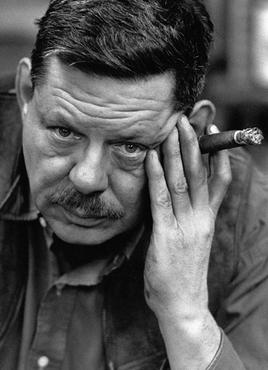
Roland David Smith was an influential and innovative American abstract expressionist sculptor and painter, widely known for creating large steel abstract geometric sculptures.
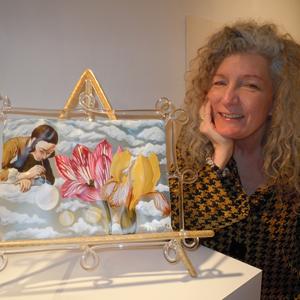
Ginny Ruffner is a pioneering American glass artist based in Seattle, Washington. She is known for her use of the lampworking technique and for her use of borosilicate glass in her painted glass sculptures.

Hyperbaric welding is the process of extreme welding at elevated pressures, normally underwater. Hyperbaric welding can either take place wet in the water itself or dry inside a specially constructed positive pressure enclosure and hence a dry environment. It is predominantly referred to as "hyperbaric welding" when used in a dry environment, and "underwater welding" when in a wet environment. The applications of hyperbaric welding are diverse—it is often used to repair ships, offshore oil platforms, and pipelines. Steel is the most common material welded.
Carmen Herrera was a Cuban-born American abstract, minimalist visual artist and painter. She was born in Havana and lived in New York City from the mid-1950s. Herrera's abstract works brought her international recognition late in life.

Claire Falkenstein was an American sculptor, painter, printmaker, jewelry designer, and teacher, most renowned for her often large-scale abstract metal and glass public sculptures. Falkenstein was one of America's most experimental and productive 20th-century artists.
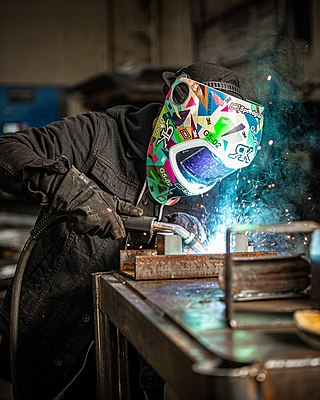
Gas metal arc welding (GMAW), sometimes referred to by its subtypes metal inert gas (MIG) and metal active gas (MAG) is a welding process in which an electric arc forms between a consumable MIG wire electrode and the workpiece metal(s), which heats the workpiece metal(s), causing them to fuse. Along with the wire electrode, a shielding gas feeds through the welding gun, which shields the process from atmospheric contamination.
Lila Katzen, born Lila Pell, was an American sculptor of fluid, large-scale metal abstractions.
Li Xiuqin is a Chinese contemporary sculptor, professor, and the co-director of the 4th Studio of Sculpture Department of China Academy of Art (CAA), Hangzhou. She lives and works in Hangzhou, China.
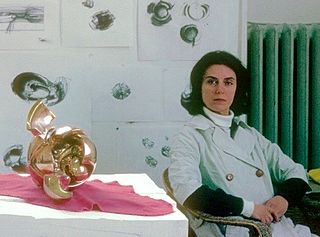
Luise Clayborn Kaish was an American artist known for her work in sculpture, painting, and collage. Throughout her career, Kaish's work was exhibited and collected by major museums, including the Smithsonian Institution's National Museum of American Art, the Museum of Modern Art, the Whitney Museum, the Jewish Museum, and the Metropolitan Museum of Art. Kaish created monumental sculptures in bronze, aluminum, and stainless steel, which remain on view in educational, religious, and commercial settings across the United States and internationally.
Margaret Wharton (1943-2014) was an American artist, known for her sculptures of deconstructed chairs. She deconstructed, reconstructed and reimagined everyday objects to make works of art that could be whimsical, witty or simply thought-provoking in reflecting her vision of the world.
Carmen Argote is a Los Angeles-based artist. She hails from Guadalajara. She is known for performance art and sculpture. Her work has been included in exhibitions and museum collections, including the Hammer Museum, the Los Angeles County Museum of Art, Denver Art Museum, Orange County Museum of Art and the National Museum of Mexican Art. She was a recipient of the Artadia Award in 2019, the Rema Hort Mann Foundation YoYoYo Grant in 2015, and a California Community Foundation Emerging Artist Grant in 2013. In 2016, the LA Weekly named Argote their "Best Up and Coming Artist".
References
- 1 2 3 4 Emell Derra Adolphus (February 13, 2019). "Women who Rock: This Barbie is a master welder". Snips Magazine.
- ↑ "Welding Tips and Tricks Podcast Episode 43 Barbie The Welder from Welding Tips and Tricks Podcast". www.stitcher.com. Retrieved May 25, 2018.
- 1 2 3 4 "Midday Makeover: Barbie the Welder" (video, 5 mins, 28 secs). WENY. July 2, 2018 [March 27, 2018]. Retrieved May 18, 2019. Interview transcript: "Barbie the Welder on WENY TV". Wellness Arts Network. April 11, 2018. Retrieved May 18, 2019.
- 1 2 "This Barbie is living in a welding world". My Twin Tiers.com (with video, 3 mins, 28 secs). WETM. March 20, 2019. Retrieved May 18, 2019.
- ↑ "Welding Giant Angel Wings – Carmen Electrode Blog". www.arc-zone.com. December 18, 2014. Retrieved May 25, 2018.
- 1 2 "Barbie the Welder: The Journey". WeldingSource.org (video, 3 mins, 27 secs). September 21, 2017. Archived from the original on January 26, 2018. Retrieved May 25, 2018. Also at: "Barbie the Welder: The Journey". YouTube. American Welding Society. October 17, 2017.
- ↑ "About the Artist". Barbie the Welder. Archived from the original on June 10, 2018. Retrieved May 25, 2018.
- ↑ Chelsea Lovell (January 28, 2022). "Barbie the Welder: Her story and her latest work 'Rise Up'". My Twin Tiers.
- ↑ "Barbie the Welder has built her own dream garage". Carmen Electrode. August 22, 2018. Retrieved May 21, 2019.
- ↑ "Studio". BarbieTheWelder. Retrieved May 25, 2018.
- ↑ "This Barbie has Built Her Own Dream Garage". Carmen Electrode. August 22, 2018. Retrieved May 18, 2019.
- ↑ "Barbie The Welder creates metal sculpture art with Miller Welders". Miller Welders. Retrieved May 16, 2019.
- ↑ "Miller to Unveil AC TIG-Capable Multiprocess Solution and Offer Live Welding Demos at SEMA". Body Shop Business. October 19, 2018. Retrieved May 16, 2019.
- ↑ "Barbie The Welder". Simon and Schuster. Retrieved May 24, 2019.
- ↑ How to Weld Scrap Metal Art: 30 Easy Welding Projects You Can Make at Home. Barbie The Welder. November 26, 2019. ISBN 9781647647933 – via Amazon.